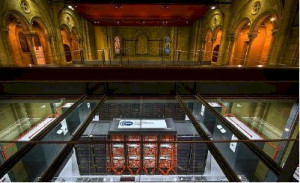Nearly four years ago, EuroHPC announced sites for eight new supercomputers as the nascent initiative debuted. MareNostrum 5, the third of the so-called “pre-exascale” EuroHPC systems, is set to round out those first eight at long last when it debuts this summer at the Barcelona Supercomputing Center (BSC). Now, we have a few more details on how the installation is going courtesy of BSC’s operations director, Sergi Girona.
“The installation is mostly following the contractual plan,” Girona told HPCwire. “The storage system (hard drives and tapes) with the corresponding servers has been delivered at this stage.”
As part of the storage system installation for MareNostrum 5, BSC held an event in which its employees were able to help install tape cartridges. “This concerned the active archive system of MareNostrum 5, which consists of two libraries with 13 modules and 10,000 cartridges each,” Girona said. “This was a good opportunity to engage BSC employees in the installation of MareNostrum 5 in a safe way. More than 100 people were involved in the event to put in place the complete set of tapes of one full library.”

“Participants enjoyed the invitation to the datacenter,” he added. “Some also took the occasion to ask for additional disk space quota.” (To learn more about the installation event, check out BSC’s social media posts on Twitter and Instagram.)
EuroHPC’s details on the storage system show it is expected to have 248PB of net capacity – but of course, MareNostrum 5 will be far more than its storage system. The supercomputer will include four main partitions: one accelerated partition powered by Nvidia Hopper GPUs and Intel Sapphire Rapids CPUs; a second accelerated partition powered by Intel Rialto Bridge GPUs (the successor to the Sapphire Rapids/”Max” series GPU) and next-gen Intel Emerald Rapids CPUs; a CPU partition powered by Sapphire Rapids CPUs; and a second CPU partition powered by Nvidia Grace Superchips. (To learn more about the system’s architecture, read our prior coverage here.)
“The next delivery will bring the management racks, including Ethernet switches,” Girona said. “This will be the kick-off for the software installation of the management racks and also for the file system and archive system. General-purpose compute racks are expected by the end of February, with InfiniBand core switches as well. Right after, accelerated computing racks will arrive.”
“We expect the final acceptance of the system by the end of June, with an early access program in June/July,” Girona continued, “leading to the system’s general availability to EuroHPC, Turkish, Portuguese and Spanish users by September.”

MareNostrum 4 is housed in a famously beautiful datacenter built into a converted chapel. Its successor will be housed in a datacenter in BSC’s new headquarters adjacent to the chapel (pictured in the header) – and that new datacenter will have its own tricks up its sleeve.
“Building a new datacenter nicer than the chapel is a significant challenge,” Girona said. “Nevertheless, we are working hard to make sure the new datacenter is as interesting, with a great view of the supercomputer, interactions with the HPC system and its cooling environment and two large sets of projection systems that will guarantee to attract even more people to BSC than today.”
“In any case, the chapel will stay in operation for other systems, probably hosting the quantum computers from the Spanish quantum initiative and EuroHPC quantum call,” Girona added.
The new datacenter’s cooling system includes four circuits capable of moving 3,000 cubic meters of water per hour. As is becoming typical with major European supercomputers of late, the waste heat from the massive cooling system (capable of drawing 17MW) will be reused – in this case, for heating the building that houses the datacenter and the adjacent university campus. Girona said upgrades to the cooling system are already planned, with an osmotic plant in the works to improve water quality.




























































